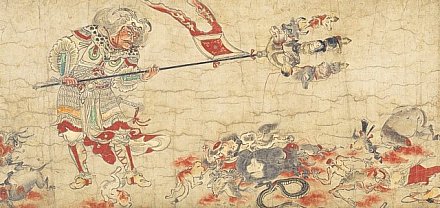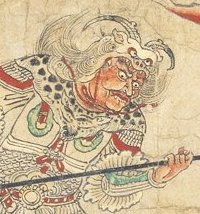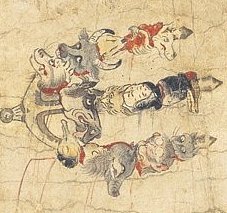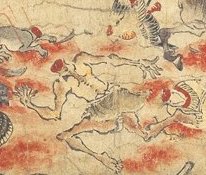|

Sendan Kendatsuba 栴檀乾闥婆
or Sendan Kandatsuba Ō 栴檀乾闥婆王
Buddhist Guardian of Children, One Who Expels Demons of Plague
Origin: Vedic Mythology
Sendan Kendatsuba (Sanskrit = Cadana Gandharva)
One of the Kings of the Kendatsuba, who are members of the
8 Legions, the 28 Legions, and the 33 Manifestations of Kannon Bosatsu.
Sendan Kendatsuba is the central figure in the Dōjikyō Mandala 童子経曼荼羅 of
Esoteric Buddhism, which was used in rituals to protect children from illness & danger.

Sendan Kendatsuba as depicted in the Hekija-e 辟邪絵 (Exorcist) Scroll.
Sendan Kendatsuba in human guise hoisting the severed heads of
evil animals and demons on a trident, with their remains at his feet
Late Heian Period. Treasure of Sanjūsangendō 三十三間堂 in Kyoto.
Above photo courtesy the Tokyo National Museum
HISTORICAL NOTES. In early Vedic mythology from India, the Kendatsuba (Skt. = Gandharva) were known for their skills with horses and music, and for their ability to cast illusions. They were also spirits of the mountains, air, and forests, and sometimes served as attendants to the Deva. The Kendatsuba were also a class of beings who protected and served Soma. Later, the Kendatsuba became musicians in the heavenly court of Taishakuten (Skt. = Indra) and protectors of Buddhist teachings, as well as deities of medicine and guardians of children. In paintings, they are sometimes depicted sitting in royal ease surrounded by the twelve Zodiac animals. Sometimes shown with halo; said to nourish themselves on scents. Sendan Kendatsuba is one of the Kings of the Kendatsuba. Sendan 栴檀 is a tree and a term for sandalwood. The tree's bark is a medicinal herb and used also as incense.
 Says JAANUS: Kendatsuba 乾闥婆 is a transliteration of the Sanskrit Cadana Gandharva, translated as Jikikou 食香 ("scent-eater" ), Jinkou 尋香 ("scent-seeker"); also known as Koujin 香神 ("scent god"). A class of semi-divine beings said to feed on the fragrance of herbs. In later Indian mythology they are regarded as celestial musicians, in which role they were incorporated into Buddhism as attendants of Taishakuten 帝釈天, who is a protector of Buddhist law. They are also counted among the attendants of Jikokuten 持国天, the guardian king of the eastern direction, among the eight classes of beings that protect Buddhism (Hachi-bushu), and among the 28 classes of beings (the Nijuuhachi-bushuu) that serve as attendants to the Senju Kannon, as well as among the 33 manifestations of Kannon mentioned in the Lotus Sutra. They are also regarded as guardians of children, and it is in this role that one of their kings, called Sendan Kendatsuba, figures at the centre of the Doujikyou Mandara 童子経曼荼羅, which is used in Esoteric Buddhist rituals to ward off danger and illness from children. They are generally depicted clad in armour and holding a trident. Says JAANUS: Kendatsuba 乾闥婆 is a transliteration of the Sanskrit Cadana Gandharva, translated as Jikikou 食香 ("scent-eater" ), Jinkou 尋香 ("scent-seeker"); also known as Koujin 香神 ("scent god"). A class of semi-divine beings said to feed on the fragrance of herbs. In later Indian mythology they are regarded as celestial musicians, in which role they were incorporated into Buddhism as attendants of Taishakuten 帝釈天, who is a protector of Buddhist law. They are also counted among the attendants of Jikokuten 持国天, the guardian king of the eastern direction, among the eight classes of beings that protect Buddhism (Hachi-bushu), and among the 28 classes of beings (the Nijuuhachi-bushuu) that serve as attendants to the Senju Kannon, as well as among the 33 manifestations of Kannon mentioned in the Lotus Sutra. They are also regarded as guardians of children, and it is in this role that one of their kings, called Sendan Kendatsuba, figures at the centre of the Doujikyou Mandara 童子経曼荼羅, which is used in Esoteric Buddhist rituals to ward off danger and illness from children. They are generally depicted clad in armour and holding a trident.
 PHOTOS ON THIS PAGE & BELOW TEXT PHOTOS ON THIS PAGE & BELOW TEXT
Courtesy of the Tokyo National Museum. All the deities shown here are considered, in China, to be benevolent deities who expel the “demons of plague.” This set was originally mounted as a handscroll that was known as the "second edition of the Masuda Family Hell Scroll." After the war, the handscroll was cut into sections and the paintings mounted as hanging scrolls. The acts of each of the gods in exterminating evil are briefly explained in the texts accompanying the illustrations.
Sendan Kendatsuba was originally an Indian god of music. Later, he came to be classified as being one among the Eight Classes of Protectors of the Buddhist Law (J. hachibushu) and is described in the Lotus Sutra as one of the 33 manifestations of the Avalokitesvara (i.e., Kannon Bosatsu). He is also believed to protect youths from the dangers of the fifteen malevolent deities. Here, his form closely resembles that found in the Esoteric Buddhist Mandala of Youths (J. Doji Mandara).
 This scroll set, which brings together a number of unusual images, has had strong connections to the Southern Capital of Nara and to the Hell Transformation Screens (J. Jigokuhen gobyobu), which were used in year-end repentance ceremonies, held at the Imperial Palace up until the Heian period, in which the names of the buddhas were recited (J. butsumyoe). Like other paintings of the Six Paths (J. Rokudo-e) such as the Hell Scroll, it is conjectured to have been made during the time of Emperor Goshirakawa (1127-92, r. 1155-58) in the latter part of the Heian period (794-1185) and kept in the treasure house of Rengeo-in Temple (Sanjusangendo). One view holds that the calligraphy for the Extermination of Evil (Hekija-e, or Exorcists Scroll) was brushed by the same hand as that of the Hell Scroll (J. Jigoku zoshi) in the Tokyo National Museum and the Demon of Punishment (J. Kando no oni) in the Fukuoka City Museum of Art. This scroll set, which brings together a number of unusual images, has had strong connections to the Southern Capital of Nara and to the Hell Transformation Screens (J. Jigokuhen gobyobu), which were used in year-end repentance ceremonies, held at the Imperial Palace up until the Heian period, in which the names of the buddhas were recited (J. butsumyoe). Like other paintings of the Six Paths (J. Rokudo-e) such as the Hell Scroll, it is conjectured to have been made during the time of Emperor Goshirakawa (1127-92, r. 1155-58) in the latter part of the Heian period (794-1185) and kept in the treasure house of Rengeo-in Temple (Sanjusangendo). One view holds that the calligraphy for the Extermination of Evil (Hekija-e, or Exorcists Scroll) was brushed by the same hand as that of the Hell Scroll (J. Jigoku zoshi) in the Tokyo National Museum and the Demon of Punishment (J. Kando no oni) in the Fukuoka City Museum of Art.
LEARN MORE
|